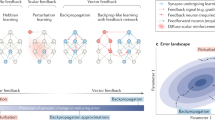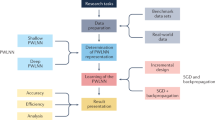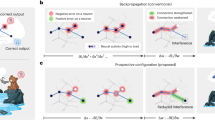Abstract
We describe a new learning procedure, back-propagation, for networks of neurone-like units. The procedure repeatedly adjusts the weights of the connections in the network so as to minimize a measure of the difference between the actual output vector of the net and the desired output vector. As a result of the weight adjustments, internal ‘hidden’ units which are not part of the input or output come to represent important features of the task domain, and the regularities in the task are captured by the interactions of these units. The ability to create useful new features distinguishes back-propagation from earlier, simpler methods such as the perceptron-convergence procedure1.
This is a preview of subscription content, access via your institution
Access options
Subscribe to this journal
Receive 51 print issues and online access
$199.00 per year
only $3.90 per issue
Buy this article
- Purchase on SpringerLink
- Instant access to full article PDF
Prices may be subject to local taxes which are calculated during checkout
Similar content being viewed by others
References
Rosenblatt, F. Principles of Neurodynamics (Spartan, Washington, DC, 1961).
Minsky, M. L. & Papert, S. Perceptrons (MIT, Cambridge, 1969).
Le Cun, Y. Proc. Cognitiva 85, 599–604 (1985).
Rumelhart, D. E., Hinton, G. E. & Williams, R. J. in Parallel Distributed Processing: Explorations in the Microstructure of Cognition. Vol. 1: Foundations (eds Rumelhart, D. E. & McClelland, J. L.) 318–362 (MIT, Cambridge, 1986).
Author information
Authors and Affiliations
Rights and permissions
About this article
Cite this article
Rumelhart, D., Hinton, G. & Williams, R. Learning representations by back-propagating errors. Nature 323, 533–536 (1986). https://doi.org/10.1038/323533a0
Received:
Accepted:
Issue Date:
DOI: https://doi.org/10.1038/323533a0



